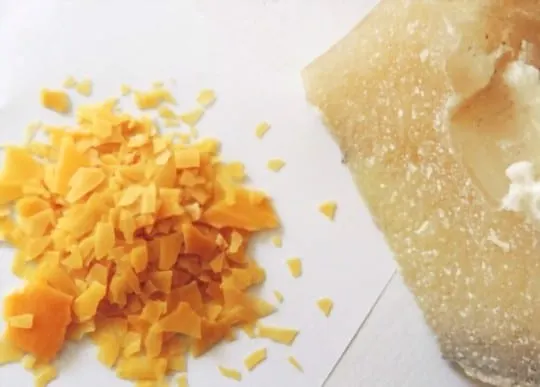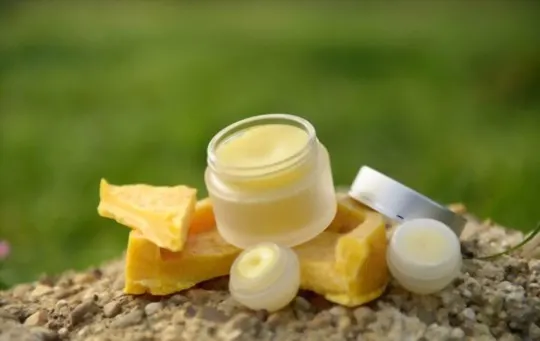Beeswax is one of those substances that serve many different purposes.
Being a natural ingredient, it’s a handy item to have at home, and you can do a lot of things with it.
Suppose you need it for something but find out that there is none left.
Obviously, you will be mad because sometimes, even the stores may not have it when you require it desperately.
If you wonder what to do, there is nothing to stress about.
There are several items that you can use when beeswax is not available.
We have chosen some ingredients to replace the original item when it’s not there.
Check out the 5 best substitutes for beeswax in the coming sections.
What is Beeswax?

Beeswax is a natural substance that bees secrete to make honeycombs.
The manufactured variety made from the honeycomb of many types of bees, including honeybees, also goes by the same name.
It’s a versatile product used in many industries.
For centuries, people have used it for different purposes in its natural form.
Now, you can get beeswax in various shapes and sizes, which manufacturers extract and pack using advanced technology.
You can use it to make candles at home, polish wood, make lip balm, use in cooking and beeswax wraps.
The 5 Best Substitutes for Beeswax
If you use beeswax regularly but don’t have it at the moment, you can use the following items instead.
1 – Candelilla Wax

The first replacement for beeswax is candelilla wax.
It’s made from the extract of leaves from the candelilla shrub indigenous to Mexico and the north-western USA.
Its shade is yellowish-brown and very hard but brittle and can be solid or translucent.
It’s a popular ingredient in lip balms, varnishes, foot creams and lotion bars.
It’s also used as a binding agent in chewing gums and used as a food additive.
Candelilla wax falls in the category of vegetable wax.
Hence, it can be a suitable beeswax replacement for vegans.
You can also use it in many DIY projects at home.
You can make crayons, candles, wraps and also use it to polish wooden furniture, decorative items, doors and floors.
Since Candelilla wax is exceptionally dense, the ratio would be.
- 2 units of beeswax = 1 unit of candelilla wax.
2 – Carnauba Wax

Also known as ‘Queen of Waxes,’ it’s extracted from carnauba palm leaves.
Native to Brazil, it also goes by the name palm wax and Brazil wax, and the people call the plant the tree of life because of its many uses.
It, however, grows only in six states of north-eastern part of the country.
Carnauba wax is yellow-brown in its pure form and is available in flakes, and it’s also a popular ingredient in various industries.
You can find it in products like shoe polish, dental floss, paper coatings, automobile wax and varnishes.
The cosmetic industry also uses it in many products, including creams, deodorant, lipstick, mascara, eyeshadow and eyeliner.
It’s, however, pretty brittle and is mixed with other waxes.
The food industry also uses it in several products.
Like Candelilla wax, it’s also a suitable vegan option.
Carnauba wax is also denser than beeswax, so the right ratio would be.
- 1gm beeswax = 0.8gms carnauba wax.
3 – Soy Wax
Soy is a popular food item in Asian cuisine. It belongs to the pea family.
It’s a nutritious legume and very versatile as you can make different types of things, including tofu, soy milk, tempeh, etc.
Soy also produces oil, and many brands convert the oil to wax to make a lot of items.
The waxy form is known as soy wax.
It’s used in engine lubricants, crayons, candles, and lip balms.
You can find pure soy wax in pellet or flake form, and its shade is light yellow or ivory.
Soy candles are safe and lovely, but they are likely to melt in hot conditions, so they come in containers.
It’s also a suitable replacement for people who want to use only vegan products.
However, there are many genetically modified varieties, so you can look for natural ones.
Besides, many soy wax products may have other waxes.
So, check the ingredients before buying any stuff.
Soy wax is lighter than beeswax, and so the right ratio would be.
- 25% beeswax = 75% soy wax.
- If you are using four pieces, take one 1 beeswax for every 3 soy wax.
4 – Bayberry Wax

The next option on the list is bayberry wax.
Also known as Northern bayberry (Myrica pensylvanica) or wax myrtle, it’s a deciduous shrub that grows abundantly in the eastern region of North America.
Manufacturers boil the berries and collect the wax from the surface of the water.
It has a lovely fragrance and is a popular ingredient in the candle and soap industries.
You can find different varieties of bayberry soaps and candles across the eastern part of the US.
These days, chefs are also experimenting with bayberry in their dishes.
Bayberry is also a popular ingredient in traditional medicine in many places.
People take concoctions as a gargle for sore throat, to alleviate diarrhea and to relieve head colds.
However, there is both an upside and downside regarding bayberry wax.
The upside is it’s a suitable vegan choice, and the downside is it’s rather expensive.
The suitable ratio of bayberry wax to beeswax would be.
- 2gms bayberry wax = 1gm beeswax.
5 – Olive Wax

Finally, we have olive wax derived from olive oil.
In its pure form, it’s semi-solid, odorless and white.
The wax is suitable to make hair and skin products.
It’s softer than beeswax, and so for candle making, mixing with other resins can produce great results.
Pure olive oil offers many health benefits as it contains antioxidants, vitamins and healthy fatty acids.
The ingredients can help fight inflammation and lower the risk of chronic illnesses like heart diseases.
Olive wax is a healthy option if you don’t have beeswax.
If you are a strict vegan then, it’s a perfect choice.
However, it’s not readily available and can be expensive.
You can use equal parts of beeswax to olive wax as.
- 1gm beeswax = 1gm olive wax.
But you can add more according to requirements too.
Conclusion
So, these are the five best substitutes for the beeswax, especially if you want to use vegan products.
There are also several other items that you can use if the varieties mentioned above are not available.
They include synthetic beeswax, paraffin wax, sunflower wax, and rice bran wax.
But if you plan to buy these, check the ingredients carefully.
Some products have beautiful names, but their composition can contain substances that are not healthy.
If you strictly use vegan products, you should also see that there are no animal-based ingredients.

The 5 Best Substitutes for Beeswax
Ingredients
- Candelilla Wax
- Carnauba Wax
- Soy Wax
- Bayberry Wax
- Olive Wax
Instructions
- Choose your prefered substitute from the list of options.
- Organize all of your ingredients.
- Follow the substitution ratio to determine how much is required in your recipe.
